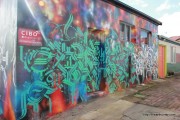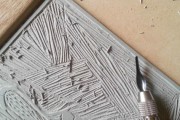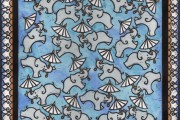
Writing about the work of this Artist is a joy. I first came across his work “Floe“, 2009, while casually browsing the net. The first thing that one notices when they look at it is that they drawn into it. It is calming, glacial and beautiful. What interests your eye first is the cacophony of assembled pieces that bubble and bulge before the viewer. Suspended by woven fishing line in great berg like clumps, this work is ominous. Folland utilised over 1000 glass and crystal objects after scouring Op shops around Adelaide. They are things that are recognisable to all of us. They are the pretty heirlooms once tucked away in cupboards, the hard to discard wedding gifts that you bring out for special occasions. “Floe“, as with many of Folland’s artworks, carries with it a certain tension. In researching it I read; that for one writer at least, it evoked the feelings of melting polar ice caps and linked its creation with the climate change phenomenon. I do not see that in this work. It is, for me, a colossal rendition of the memories associated with objects from our lives. “Floe” is almost an archaeological experience. Why did Folland choose to name it as if it was a person, unless there was to be a personal touch to it? There is a history within the hanging trinkets. Once they graced people’s home crystal and glassware collections. One object may have been great Nanna’s cake platter; another, precious wine goblets used at Christmas. This piece evokes special feelings within the beholder as one’s memories are stirred. The most interesting aspect surrounding “Floe” is the lighting. Lit brightly from above it reverberates throughout the exhibition space. Notice the beautiful, etherial reflections upon the gallery floor. This work is deep and mysterious it is something majestic and such things invite contemplation.
 Other works by Nicholas Folland demand similar attention toward the historical aspects of the objects he has used. While they may have been reworked or positioned by the artist they were also once owned and loved. When looking at an assemblage work it is important to acknowledge the power that may be evoked in the history behind the objects used. Another good example of his work titled “Tools“, 2010. In This work Folland has assembled various knives and suspended them vertically. The blades point down. These knives also each have a story to tell. Sharpened over time; they are old and worn. They may have been owned by a butcher, farmer or suburban home. They have been present at countless meals, cut bread and spread butter. Folland has used repletion of form to create an interesting rhythm in this work. The base of each handle has been positioned to create a horizontal line onto which the eye can rest and return to after visually experiencing the handles and the blades. I love how this piece “reads” with the careful implementation of the coloured handles to alter the pattern. I can look at it for hours.
Other works by Nicholas Folland demand similar attention toward the historical aspects of the objects he has used. While they may have been reworked or positioned by the artist they were also once owned and loved. When looking at an assemblage work it is important to acknowledge the power that may be evoked in the history behind the objects used. Another good example of his work titled “Tools“, 2010. In This work Folland has assembled various knives and suspended them vertically. The blades point down. These knives also each have a story to tell. Sharpened over time; they are old and worn. They may have been owned by a butcher, farmer or suburban home. They have been present at countless meals, cut bread and spread butter. Folland has used repletion of form to create an interesting rhythm in this work. The base of each handle has been positioned to create a horizontal line onto which the eye can rest and return to after visually experiencing the handles and the blades. I love how this piece “reads” with the careful implementation of the coloured handles to alter the pattern. I can look at it for hours.
Nicholas Folland is currently working on an installation for the Adelaide Biennial opening March 2 at AGSA, similar to the work Floe. I can not wait to see it.



